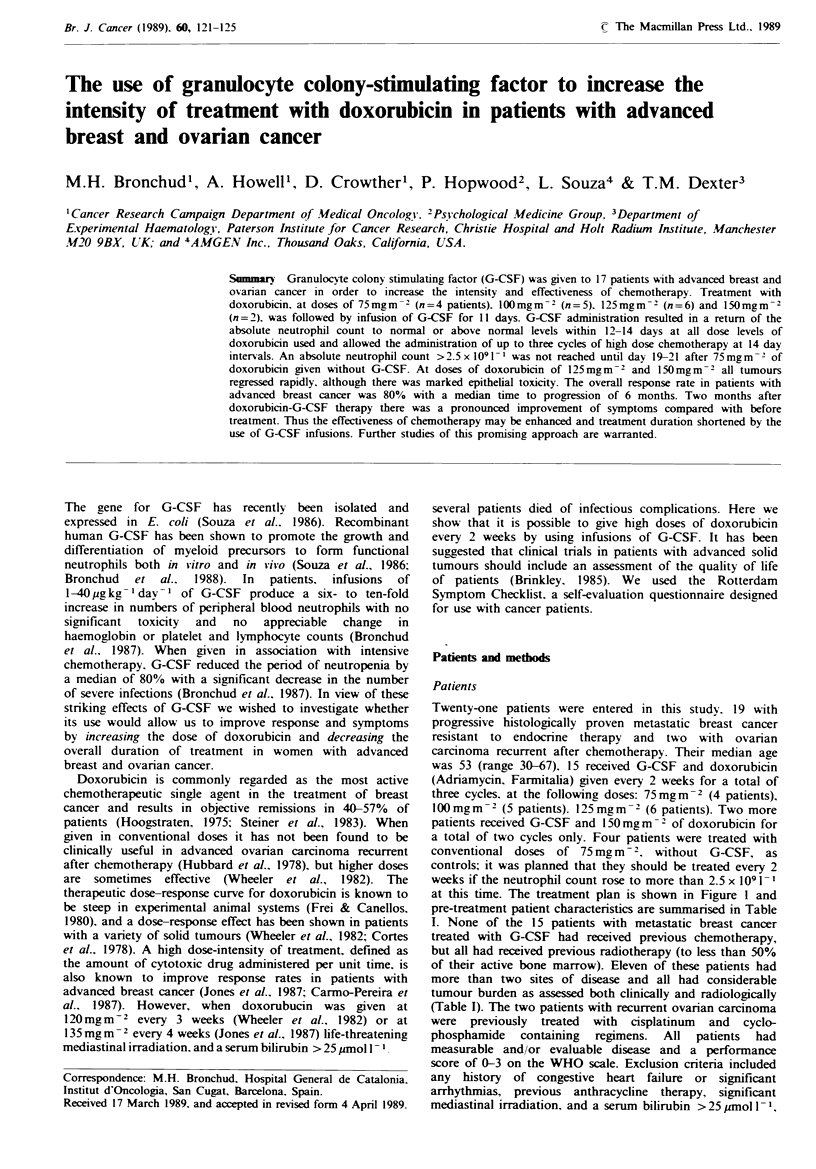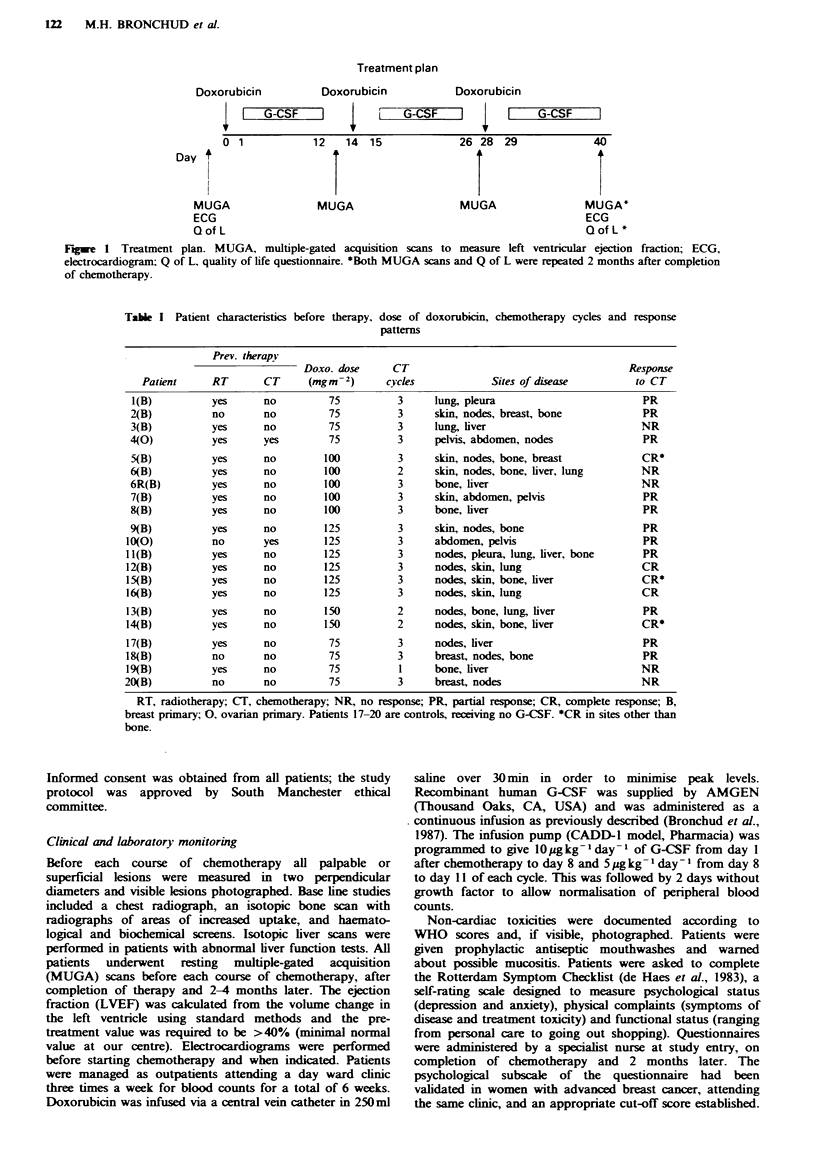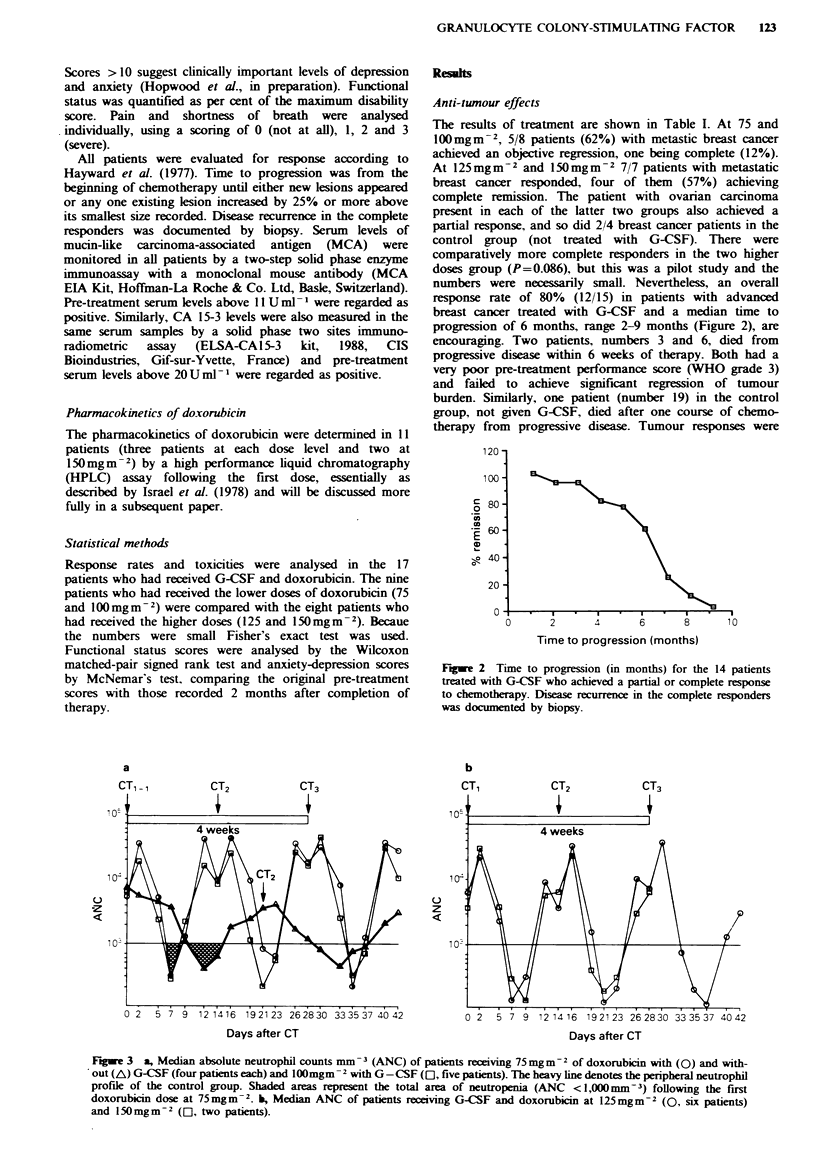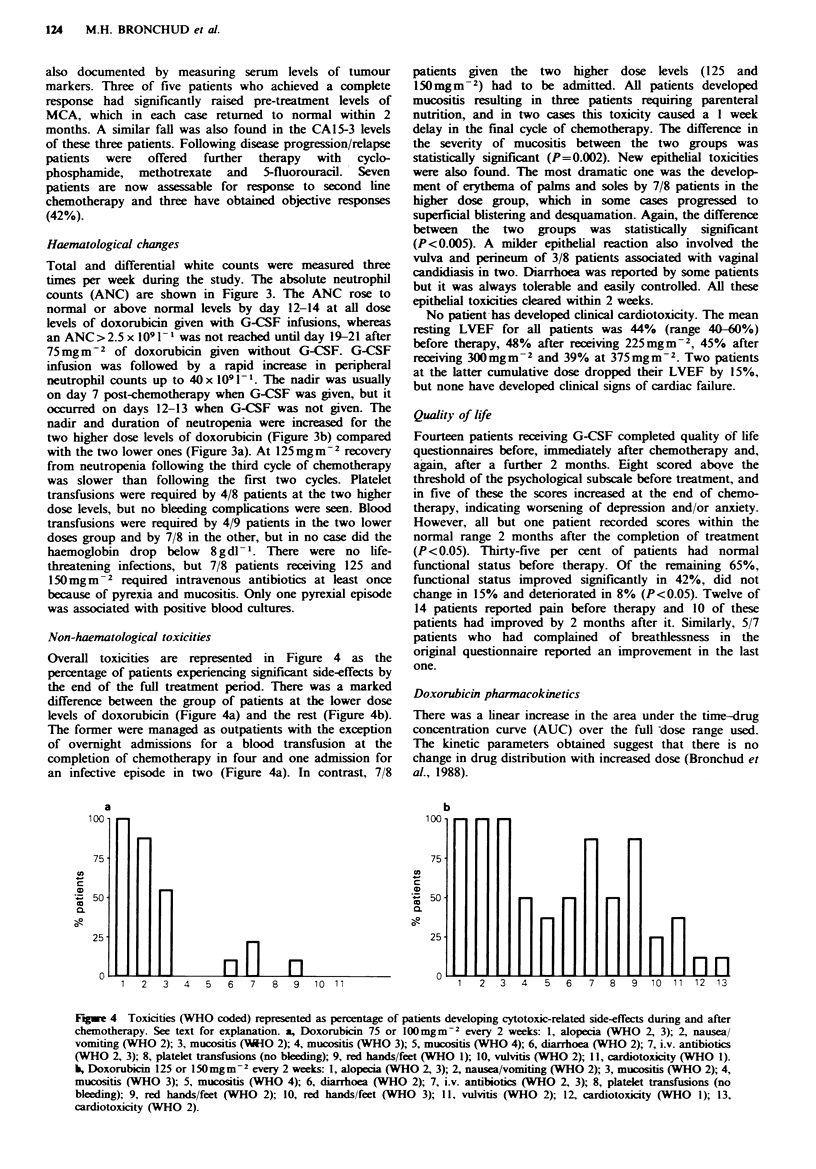Abstract
Granulocyte colony stimulating factor (G-CSF) was given to 17 patients with advanced breast and ovarian cancer in order to increase the intensity and effectiveness of chemotherapy. Treatment with doxorubicin, at doses of 75 mg m-2 (n = 4 patients), 100 mg m-2 (n = 5), 125 mg m-2 (n = 6) and 150 mg m-2 (n = 2), was followed by infusion of G-CSF for 11 days. G-CSF administration resulted in a return of the absolute neutrophil count to normal or above normal levels within 12-14 days at all dose levels of doxorubicin used and allowed the administration of up to three cycles of high dose chemotherapy at 14 day intervals. An absolute neutrophil count greater than 2.5 x 10(9)l-1 was not reached until day 19-21 after 75 mg m-2 of doxorubicin given without G-CSF. At doses of doxorubicin of 125 mg m-2 and 150 mg m-2 all tumours regressed rapidly, although there was marked epithelial toxicity. The overall response rate in patients with advanced breast cancer was 80% with a median time to progression of 6 months. Two months after doxorubicin-G-CSF therapy there was a pronounced improvement of symptoms compared with before treatment. Thus the effectiveness of chemotherapy may be enhanced and treatment duration shortened by the use of G-CSF infusions. Further studies of this promising approach are warranted.
Full text
PDF




Selected References
These references are in PubMed. This may not be the complete list of references from this article.
- Antman K., Gale R. P. Advanced breast cancer: high-dose chemotherapy and bone marrow autotransplants. Ann Intern Med. 1988 Apr;108(4):570–574. doi: 10.7326/0003-4819-108-4-570. [DOI] [PubMed] [Google Scholar]
- Brinkley D. Quality of life in cancer trials. Br Med J (Clin Res Ed) 1985 Sep 14;291(6497):685–686. doi: 10.1136/bmj.291.6497.685. [DOI] [PMC free article] [PubMed] [Google Scholar]
- Bronchud M. H., Scarffe J. H., Thatcher N., Crowther D., Souza L. M., Alton N. K., Testa N. G., Dexter T. M. Phase I/II study of recombinant human granulocyte colony-stimulating factor in patients receiving intensive chemotherapy for small cell lung cancer. Br J Cancer. 1987 Dec;56(6):809–813. doi: 10.1038/bjc.1987.295. [DOI] [PMC free article] [PubMed] [Google Scholar]
- Carmo-Pereira J., Costa F. O., Henriques E., Godinho F., Cantinho-Lopes M. G., Sales-Luis A., Rubens R. D. A comparison of two doses of adriamycin in the primary chemotherapy of disseminated breast carcinoma. Br J Cancer. 1987 Oct;56(4):471–473. doi: 10.1038/bjc.1987.226. [DOI] [PMC free article] [PubMed] [Google Scholar]
- Cortes E. P., Holland J. F., Glidewell O. Amputation and adriamycin in primary osteosarcoma: a 5-year report. Cancer Treat Rep. 1978 Feb;62(2):271–277. [PubMed] [Google Scholar]
- De Vita V. T., Jr, Hubbard S. M., Longo D. L. The chemotherapy of lymphomas: looking back, moving forward--the Richard and Hinda Rosenthal Foundation award lecture. Cancer Res. 1987 Nov 15;47(22):5810–5824. [PubMed] [Google Scholar]
- DeVita V. T. Dose-response is alive and well. J Clin Oncol. 1986 Aug;4(8):1157–1159. doi: 10.1200/JCO.1986.4.8.1157. [DOI] [PubMed] [Google Scholar]
- Frei E., 3rd, Canellos G. P. Dose: a critical factor in cancer chemotherapy. Am J Med. 1980 Oct;69(4):585–594. doi: 10.1016/0002-9343(80)90472-6. [DOI] [PubMed] [Google Scholar]
- Hayward J. L., Carbone P. P., Heusen J. C., Kumaoka S., Segaloff A., Rubens R. D. Assessment of response to therapy in advanced breast cancer. Br J Cancer. 1977 Mar;35(3):292–298. doi: 10.1038/bjc.1977.42. [DOI] [PMC free article] [PubMed] [Google Scholar]
- Henderson I. C., Hayes D. F., Gelman R. Dose-response in the treatment of breast cancer: a critical review. J Clin Oncol. 1988 Sep;6(9):1501–1515. doi: 10.1200/JCO.1988.6.9.1501. [DOI] [PubMed] [Google Scholar]
- Hortobagyi G. N. The role of high-dose chemotherapy with autologous bone marrow transplantation in the treatment of breast cancer. Bone Marrow Transplant. 1988 Nov;3(6):525–530. [PubMed] [Google Scholar]
- Hubbard S. M., Barkes P., Young R. C. Adriamycin therapy for advanced ovarian carcinoma recurrent after chemotherapy. Cancer Treat Rep. 1978 Sep;62(9):1375–1377. [PubMed] [Google Scholar]
- Jones R. B., Holland J. F., Bhardwaj S., Norton L., Wilfinger C., Strashun A. A phase I-II study of intensive-dose adriamycin for advanced breast cancer. J Clin Oncol. 1987 Feb;5(2):172–177. doi: 10.1200/JCO.1987.5.2.172. [DOI] [PubMed] [Google Scholar]
- Skipper H. E. Criteria associated with destruction of leukemia and solid tumor cells in animals. Cancer Res. 1967 Dec;27(12):2636–2645. [PubMed] [Google Scholar]
- Steiner R., Stewart J. F., Cantwell B. M., Minton M. J., Knight R. K., Rubens R. D. Adriamycin alone or combined with vincristine in the treatment of advanced breast cancer. Eur J Cancer Clin Oncol. 1983 Nov;19(11):1553–1557. doi: 10.1016/0277-5379(83)90085-8. [DOI] [PubMed] [Google Scholar]
- Wheeler R. H., Ensminger W. D., Thrall J. H., Anderson J. L. High-dose doxorubicin: an exploration of the dose-response curve in human neoplasia. Cancer Treat Rep. 1982 Mar;66(3):493–498. [PubMed] [Google Scholar]


